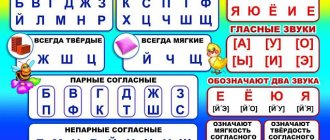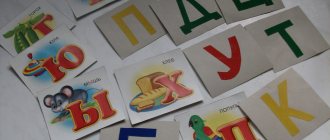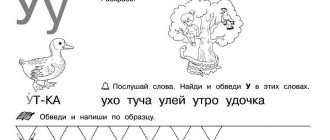Otroshko G.V., teacher-speech therapist of mixed orphanage No. 1, Yaroslavl
Mixing the letters sh and sh in children's written works and when reading occurs very often. Firstly, it can be classified as a phonemic group, since the sounds [ш] and [ш] are similar in acoustic characteristics, or articulatory - the articulomes of these sounds are also similar. Secondly, this confusion can be qualified as optical, since the graphemes sh and sh are also similar (both handwritten and printed versions). Thirdly, such mixing can be considered kinetic. In children with mental retardation, not only unformed phonemic perception is noted, but also a deficiency of visual gnosis and subtle differentiation of hand movements. It is difficult for children to correctly read the syllables she, shi, she, which are often read as shche, shchi, shche. Therefore, when working on differentiating the letters sh and sh, it is necessary to take into account all the child’s problems and approach this problem comprehensively. Comprehensive work on differentiating the confusion between w and shch makes it possible to obtain stable results and reduce the number of errors made by children with mental retardation in writing and reading. The tasks used contribute to the development of phonemic processes, visual gnosis, and motor components. Tasks and exercises Clarifying the pronunciation of the sounds sh and shch Pronunciation is clarified first separately, then differentiated. Children's attention is drawn to the acoustic signs of sounds and articulatory patterns. Forming an idea of the phonemes [ш] and [ш] Children look at pictures, name them, come up with words, sentences and stories from words with each of these sounds, work at the levels of phrase and text. Working with contour pictures is interesting for children. Coloring exercises are useful, as they help to engage hand motor skills (Fig. 1, 2).
- Name the objects whose names contain the sound [w].
- Color only objects whose names contain the sound [w].
- Name the objects whose names contain the sound [у].
- Paint only objects whose names contain the sound [у].
Differentiation of phonemes [ш] and [ш] Children at the level of isolated pronunciation of syllables, words, phrases, texts learn to distinguish sounds by ear. Work is being done with contour pictures (Fig. 3, 4).
- Color and name only the pictures whose names contain the sound [w].
- Connect the pictures with the letter w (the letter is written at the top of the picture).
- Color and name only the pictures whose names contain the sound [у].
- Match the pictures with the letter sh and sh.
- Cut out and glue pictures with letters onto two trays (on two shelves, in two circles, etc.). Come up with a sentence that would contain 2-3 names of objects from the picture, etc.
Examination of the letters Ш and Ш Children consider the letters first separately, then differentiated. The element-by-element structure of each letter, their similarities and differences are clarified. Match the letter with the images and paint them with two colors (Fig. 5). Children also sculpt letters from plasticine, make them from wire, correlate printed and written letters, look for a letter by touch in the “Wonderful Bag”, and practice finding the letters w and sh in a story picture (Fig. 6).
- Find the letters and color them with the corresponding pencils.
differentiated search for letters Ш and Ш
- Mark the letters sh and sh in different colors and establish the patterns of their location.
w w w w w w w w w w w w w w w w w w w w w w w w w w w w w w w w w w w w w w w sh sh sh sh sh sh sh sh sh sh sh sh sh sh sh sh sh sh sh sh sh sh sh sh sh sh sh
- Mark the letters sh, shch, ch, c with different pencils.
ts ch u ch n n p ch n lu h ts sh c i sch y p sch w and y q s sh q p sh y and h cl ch w q sch q nc q s sch p ts u ch u ch u shp ts w s ch s s s s s s s s s s s s s s s s s s s s s s s s s s sch z w g w sh sh n pu ts sh p sch n sch z n w w sch sh n pi sch sh m ts l ch p i ch sh m l sh p c sh i sh t ch i l l l k ch c i p ts l m sh c sh m i c m sh l h sh w u i sh m l c c h sch q q q q q q q q q q q q q q q q q q q q q q q q q q q q q q q q q q ch c ch m c p sh ch sh c ch c sch c ch Differentiated spelling of letters sh and sch
- Write letters on each other's palms, on each other's backs, and guess which letter is written (dermalexy technique).
- Write rows of letters and find patterns in their arrangement.
- Continue stitching with pencils of matching colors.
w w w w w w w w w w w w w w w w w w w w w w w w w Reading syllables with the letters sh, shch
- Read the syllables in pairs, lines, columns.
sha-scha sho-scho shu-schu ash-ash osh-osh ush-ush shi-schi she-sche sho-scho ish-isch es-esch-esch Reading and writing the letters sh and sch in words
- Read the words in pairs, columns, columns in pairs, lines.
- Find the words in the rows by highlighting the letters w and y with different pencils.
brushesgoodsqueakpike drag fluffygrovetopreedsmouse thing skinnythickbucketchershaprotectiontentaclesfingersbagstitched porridgeheadfinchbroochpotatoprotective alarmedcrushedshieldcartilage
- Write “letter dictations”, writing the letters w and sch into the diagrams of the words read, indicating their position in relation to the beginning, middle, and end of the word.
- Write the words with w and shch in two columns.
..uka ..elchok jug..in pry..ik bro..ka cro..it ..orokh ..epka ..epotka pi..it ka..a pla.. mountain..ina gr..u turn..at..elk for..itnik ver..ina Transformation of words, selection of part of a word from two offered
- Add the suffix -ish to the words. What words will you get?
fur coat - ... hat - ... hut - ... curtain - ... washer - ... pencil - ... mop - ... cloak - ... tick - ...
- In these words, replace the first letter with the letter sh or sh. What words will you get?
slipper - ... cup - ... aunt - ... T-shirt - ... disputes - ... sorry - ... flank - ... slept - ... kid - ... wreath - ... bear - ... coil - ... stranded - ... tick - ... river - ... hand - ...
- Add the syllables she or shche to the words. Write the words in two columns.
Miracles.., ray.., taught.., canvases.., ti.., voice.., beautiful.., you.., treasure.., kept.. .
- Add the syllables chic or shchik to the words. Write the words in two columns.
Dances.., winters.., karanda.., set.., shala.., treasures..., cleaning.., close.., watches.. . Working with a proposal
- Make up sentences. Write them down.
looking for things, detective, Skinny, ours, missing. carefully, I eat food well, and I need to chew it. grove, in, The best, sorrel, ours. squeaks, Tiny, box, in, puppy, Ball.
- Fill in the missing words and syllables shi or cabbage soup.
We ate … . Sour… it’s amazing how good..! There's an empty puppy in my... place. Our..x..tniks have strong..you and good..swords. working with short text
- Unravel the riddles of the letters sh and sh.
All the words have changed, the letters are mixed up. You and I read the words, Sh and sh unraveled them. The forest is dense behind the river - ... (bowl). There is a vase in the museum - ... (thicket). We heard loudly - ... (silk)! It exploded... (click). Splashing in the river... (Shurenok). Shura’s mother is calling... (little puppy). I forgive... (I will forgive) And you myself... (I ask).
- Fill in the missing syllables shi or cabbage soup.
Tina! Not Shur..te, we..! Don’t pl.. te le.. and er..! Don’t bother in the quiet of the forest... the chirping of magpies. Hear..those, they sang in the lo..near the ro..tsy of the small... - the nightingales!
- Fill in the missing letters sh and sh. Learn, write from memory.
We..onok Pu..ok St..il flaw..ok, Tooth..brush, P..ena..pot, ..her p..ku, Cha..ku goro..ku, From.. a little bit...a little bit of dust, From a plate...a speck of dust. Ta..it in ..the tree is not in time..and With mi..ki sp..ego ..harp, Ta..it feathers..to ..corner, Ta..it ..sap from the corner. Covered everything with dried crust - A well-off mink!
Why are there problems with spelling “Ш” and “Ш”
Similar questions arise if we start from the principle “as one hears, so one writes.” Indeed, in the Russian language, most semantic units are written in the same way as they are perceived by ear. For example, ask yourself how to write the following words: night, coat, auto, kangaroo. These words are written the same way they are heard. However, there is an exception with the word "helper".
Difference in spelling and pronunciation of the word "helper"
It is pronounced "pamoshnik", but this use in writing is extremely erroneous. In addition, if you pay attention to colloquial speech, people never say this word with the sound “Ш”, because it's cacophonous.
Read on the topic: How to decline correctly in Russian?
There is another similar exception. This word is “all-night vigil” – i.e. evening and morning church services. The word form is derived from the noun “night”, pronounced as “all-night”. But in writing, the correct option would be “all-night vigil.”
Sound reinforcement games
Speech therapists have a special tactic in their approach to classes: the child is offered those tasks that he likes. Children who play are much easier to teach than those who are bored.
We offer a number of games to automate the sound “sh”:
- “Snake”: the picture shows a snake that wants to get into the house. It is on the other side of the maze. The baby’s task is to help the snake crawl home by moving his finger through the maze and pronouncing the sound “sh”.
- “Help the mouse”: the plot of the game is a mouse running away from a cat. The child needs to read syllables sequentially, and then words with the letter w, so that the rodent can escape from the cat. The first time, focus on correct pronunciation, and then you can suggest increasing the speed of the mouse, reading syllables and words faster.
- “Speech therapy fairy tales with pictures”: come up with or take a ready-made fairy tale from the Internet, where there are many words with the sound “sh”. The child’s task is to read the fairy tale, pronouncing the sounds correctly.
Tongue twisters guarding diction
We suggest you remember and recite the following pure sayings for preschoolers. There are a lot of them, you can choose any to remember.
Here are a few tongue twisters for the sound J.
And this way you can train the sound Ш.
Songs for sound automation
I decided to make a small addition to Elena’s article. I love music very much, and therefore I always like to sing with children in my classes. Children enjoy repeating words with the desired sound many times in songs. Therefore, I have selected simple songs with the sound Sh for you and your children.
Start with songs in which you only need to pronounce syllables with the sh sound. Next, use songs with words that contain the sound Ш. Let the child finish and sing along these words from the text. And when he already speaks the sound Ш well enough, you can use tongue twisters or complex songs (for example, the song “Horses”).
Song "Horses"
In the song we automate the correct pronunciation of the sound Ш in phrases.
Training the correct pronunciation of the letter “Ш”
Before moving directly to the exercises for setting “Sh”, it is necessary to carry out articulatory gymnastics, which helps to increase the mobility of the speech organs.
Warm up for tongue and lips
In order to teach a child to speak correctly, his muscles must be prepared. For [Ш] you need to lift the sides and tip of the tongue. The lips are made round, but do not close completely.
Important! You can print out a visual illustration of the articulatory sound profile and review it with your child.
They begin to learn the exercises gradually. Approximate complex:
- With your mouth wide open, place your tongue outstretched on your lower lip.
- Raise the edges of the tongue so that they take the shape of a “cup”.
- Round your lips and hold in this position.
Additionally, you can do an exercise to develop breathing. A small piece of cotton wool is placed on the tip of the nose and the child must blow it upward.
Sound production
After completing breathing and articulation exercises, you can begin producing hissing sounds. There are various exercises that orient the child to the correct pronunciation of words with the letter Sh.
An effective complex for combating speech disorders:
- free flight . Make a cup out of your tongue and try to stick it out of your mouth. You need to put a small piece of cotton wool on your nose. As you exhale, the air will be pushed away from the wall of the tongue cup and rise upward, removing the cotton wool. This exercise is very simple and effective. It is especially recommended for children with a lisp;
- moving cup. Use your tongue to form a cup and begin to move it: raise and lower the edges;
- pie _ Open your mouth and place your tongue on your lower lip. Raise the side walls of the tongue so that a depression is formed along the central axis. Hold for 5-10 seconds. The exercise is aimed at strengthening the muscles of the tongue, making its lateral walls more mobile;
- ship at sea . Fold your tongue into a cup shape, lift it and hold it for 1-3 seconds, then lower it and fix it in this position for a short time;
- smile . Open your mouth and smile widely. Extend your tongue forward, placing the tip on your lower lip and the sides touching the corners of your mouth. Stay in this position for a few seconds. The exercise relaxes the tongue well. It helps in producing not only the sound Ш, but also Ж;
- swing . Open your mouth and smile. The tongue should be relaxed, flat and wide. Perform the following movements with your tongue alternately: reach to the ceiling, to the sides, to the upper and lower lips, touch the incisors, climb between the teeth and lip, touch the alveoli with the tip;
- painter _ Open your mouth slightly, smile slightly, relax your lips and fixate in this position. Imagine that the tip of your tongue is a painter’s brush, and the sky is a wall that needs to be painted. The tongue must be moved from the larynx to the teeth and back, without moving it outside the oral cavity. The exercise helps strengthen tongue control.
To pronounce complex sounds, not only production is important, but also automation. Therefore, when the child learns to pronounce Sh, you will need to move on to reinforcement exercises.
Basic methods for producing the sound “Ш”
Speech therapy classes on the letter “SH” begin with developing the pronunciation of an isolated sound. One of the most effective ways is to stage the sound from other sounds.
If the child pronounces the sound “T” well, then this is one of the easiest ways. To do this, the child must pronounce “Shhhhhh” until you achieve normal pronunciation. After this, ask him to do the same procedure, but “hiding” his tongue behind his teeth. The result is the sound “SH”.
If in doubt, you can do this yourself. The “hissing snake” exercise is suitable for consolidation. For variety, associate this sound with the sound of a deflated ball or the hiss of a cat.
Speech material:
The sound “Ш” at the beginning of a word:
- sorrel, happiness, happy;
- pike, probe, tentacles, feel, puny, squint, pike;
- rubble, chirp, chirp, goldfinch, flaunt, generosity, bounty, generous, cheek, cheeky, latch, tickle, tickle, tickle, crevice, crevice, click, puppy, sliver, pinch, pinch, chipped, chipped, stubble, generosity, cabbage soup;
- click, lye, dandy, tickle, click, lye, brush, cheek, count, abacus, count, count;
- cabbage soup, ankle, pinch, tongs, tweezers, shield, thyroid gland, shield;
The sound “Ш” in the middle of a word:
- grove, square, platform, forgive, mercy, squeaked, drag, food, philistinism, promise, treat, rotate, hinder, turn, return, boardwalk, squeak, thick, grove, mother-in-law, forest, squeak;
- thicket, click, latch, still, latch, paved, condensed, condensed milk, rattle, slums;
- calculation, miscalculation, counting;
- search, drag, shine, splash, touch, clean, thicket, treat, seek, food, whistle, clean, forgive, rinse;
- look, things, drag, box, vegetables, bream, ticks, in a box, squeaks, groves, help, drags, seeing, ticks, walking, crack, seething, boiling, buzzing, smoking, trembling, holding, speaking, looking, seeing , lying, jumping, drinking, flying, protection, protector, boiling, prophetic, future, running;
- from vegetables, koschei, forgiveness, pinch, clothespin, cave, bloodhound, gorge, treat, rotation, forgiveness, pinch, catering unit, food store, food, cave, dwelling, lizard, simpler, treat, future, torso, storage;
The sound "Ш" at the end of a word:
- bream, thing, cloak, vegetable, tick, ivy, help, power, horsetail, borscht, cartilage, pimple, help, comrade;
The sound “Ш” in a combination of consonants:
- predator, graceful, helper, powerful, vegetable, essential, general;
- bathhouse attendant, burglar, museum attendant, sawyer, sitter, diver, washer, cleaner, mason, racer, inventor;
Peculiarities of pronunciation of the morpheme [sha] in words with [cha]
To speak competently and beautifully, remember one more feature. In many words, the “ch” that comes before the “n” is pronounced as “sh”. As an example, here are female patronymics:
Maria Savvichna - pronunciation [Savvishna] Lyubov Nikitichna - [Nikitishna] Evgenia Ilyinichna - [Ilyinishna] Glafira Kuzminichna - [Kuzminishna]
Sometimes the pronounced morpheme "sha" is heard as "sha", and this is not an erroneous pronunciation in colloquial speech. The following obey the rule “as it is heard, so it is written”: meticulous, urbane, foolish, paradisiacal and towel.
Articulation
The key to good pronunciation is the correct articulation of the sounds sh and zh. To teach a child to pronounce the letters sh and z correctly, it is necessary to study one method of articulation, since the speech apparatus works almost identically when pronouncing both letters. So, in order to correctly pronounce the letter w, it is necessary to work with the articulatory apparatus as follows:
- the baby's lips should be slightly pushed forward in the shape of a tube;
- the tip of the tongue is raised to the palate so that a small gap remains between them;
- the lateral edges of the child’s tongue are pressed against the upper outer teeth, giving the tongue the shape of a cup;
- a stream of air easily passes through the unused vocal cords, creating the necessary sound.
In order to understand how to teach a child to say the letter z, it is necessary to resort to the articulation described above, while connecting the vibrations of the vocal cords. Regular exercises for making sounds are very important. These exercises can be done with a speech therapist or at home.
Mimic gymnastics
Classes begin with special articulatory gymnastics, which will prepare the speech apparatus for the exercises and relax the facial muscles.
Mimic gymnastics includes the following exercises:
- Move your lips left and right, stretching your facial muscles. Perform five times in one direction and the other, rest, repeat four more times.
- Alternately puff out your cheeks, repeating the exercise five times with a short rest.
- Frown your eyebrows, pout your lips, making an offended, capricious face. Practice an angry facial expression by pursing your lips. Make a surprised expression by raising your eyebrows. Repeat each exercise four to five times.
- Alternate rapid blinking with calm, relaxed opening and closing of the eyes.
- Trace the contour of your lips with your tongue, as if licking the remnants of jam or ice cream on your face.
- Make faces, make funny facial expressions, form your lips like a duck.
Each exercise can be accompanied by a poetic rhyme or an entertaining story. In this way, the child will not only develop facial expressions, but also train speech and memory.
Breathing exercises
After a set of articulation exercises, the child is asked to perform breathing exercises in a playful way:
- “Air football”: put a cotton ball on the table and offer to score a goal with an air stream from your mouth. To do this, the lips are folded into a tube, and the cheeks are not involved. Before teaching your child this exercise, you need to hold his cheeks with your fingers so that he does it with one even exhalation.
- “A butterfly sat on a flower”: cut out flowers and butterflies from colored cardboard and connect them with thread. Blow butterflies off flowers with a stream of air.
Articulation gymnastics
An individual speech therapy session begins with articulation gymnastics for the sound “sh”. Articulation exercises delight children. We make the sound sh while playing:
- “Hippopotamus”: open your mouth wide, count to five, then close it.
- “Frog”: stretch your mouth into a smile without changing the position of your teeth.
- “Tube”: stretch your lips with a tube, hold them.
- “Pancake”: place a wide, relaxed tongue on the lower lip.
- “Jam”: lick your upper lip with a wide, cup-shaped tongue.
- “Brush”: move your tongue across the roof of your mouth, from your teeth to your throat.




